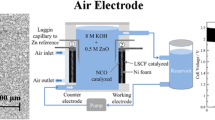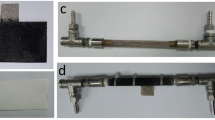Abstract
A 1 kW–4 kWh zinc-air flow battery has been built at Técnicas Reunidas facilities. The battery is divided in three different stacks connected in parallel, each of them comprising 20 cells connected in series and 0.25 m3 of electrolyte. The main challenges found on scaling up include the necessity of using three electrodes per cell, electrolyte leakage, ohmic resistance and gas diffusion electrode flooding. The three electrode solution is not optimal because it adds mechanical complexity and cost but it is a robust solution to evaluate the performance of the system as a baseline. During pilot plant operation, a phenomenon called shunt currents has revealed to reduce coulombic efficiency by 18%. In order to better understand this phenomenon, a mathematical model has been developed and it has been validated using real measurements taken on one of the 20-cell stacks. The major part of the challenges were solved and technical viability has been evaluated. However, efficiency, durability and the bifunctional air electrode are the challenges to overcome before this technology becomes ready for commercialization.
Graphical Abstract
















Similar content being viewed by others
References
IRENA (2017) Electricity storage and renewables: costs and markets to 2030. International Renewable Energy Agency, Abu Dhabi
Leung P, Li X, de Léon CP, Berlouis L, Low CT, Walsh FC (2012) Progress in flow batteries, remaining challenges and their applications in energy conversion and storage. RSC Adv 2:10125–10156. https://doi.org/10.1039/C2RA21342G
de-León CP, Frías-Ferrer A, González-Garcia J, Szánto DA, Walsh FC (2006) Redox flow cells for energy conversion. J Power Sources 160:716–732. https://doi.org/10.1016/j.jpowsour.2006.02.095
Li X, de Léon CP, Walsh FC, Wills RG, Pletcher D (2015) Chap. 8—Zinc-based flow batteries for medium- and large-scale energy storage. In: Menictas C, Skyllas-Kazacos M, Lim TM (eds) Advances in batteries for medium and large-scale energy storage. Woodhead, Cambridge, 293–315
Bockelmann M et al (2016) Electrically rechargeable zinc-oxygen flow battery with high power density. Electrochem Commun 69:24–27. https://doi.org/10.1016/j.elecom.2016.05.013
Ma H, Wang B, Fan Y, Hong W (2014) Development and characterization of an electrically rechargeable zinc-air battery stack. Energies 7:6549–6557. https://doi.org/10.3390/en7106549
Pan L, Ji L, Sun Y et al (2009) Preliminary study of alkaline single flowing Zn–O2 battery. Electrochem Commun 11:2191–2194. https://doi.org/10.1016/j.elecom.2009.09.028
Muller S, Haas O, Schlatter C, Comninellis C (1998) Development of a 100 W rechargeable bipolar zinc/oxygen battery. J Appl Electrochem 28:305–310
Price SWT, Thompson SJ, Li X, Gorman SF, Pletcher D, Russell AE, Walsh FC, Wills RGA (2014) The fabrication of a bifunctional oxygen electrodes without carbon components for alkaline secondary batteries. J Power Sources 259:43–49. https://doi.org/10.1016/j.jpowsour.2014.02.058
Fujiwara N et al (2011) Reversible air electrodes integrated with an anion-exchange membrane for secondary air batteries. J Power Sources 196:808–813. https://doi.org/10.1016/j.jpowsour.2010.07.074
Jorissen L (2006) Bifunctional oxygen/air electrodes. J Power Sources 155:23–32. https://doi.org/10.1016/jpowsour.2005.07.038
Sudoh M et al (2011) Evaluation of Ag-based gas-diffusion electrode for two-compartment cell used in novel chlor-alkali membrane process. Electrochim Acta 56:10575–10581. https://doi.org/10.1016/j.electacta.2011.06.013
Lee DU, Choi J-Y, Fen K et al (2014) Advanced extremely durable 3D bifunctional air electrodes for rechargeable zinc-air batteries. Adv Energy Mater 4:1301389. https://doi.org/10.1002/aenm.201301389
Wittmaier D, Aisenbrey S, Wagner N, Friedrich KA (2014) Bifuntional, carbon-free nickel/cobalt-oxide cathodes for lithium-air batteries with an aqueous alkaline electrolyte. Electrochim Acta 149:355–363
Huang S-Y, Ganesan P, Jung H-Y, Popov BN (2012) Development of supported bifunctional oxygen electrocatalysts and corrosion-resistant gas diffusion layer for unitized regenerative fuel cell applications. J Power Sources 198:23–29
Konig S, Suriyah MR, Leibfried T (2015) Model based examination on influence of stack series connection and pipe diameters on efficiency of vanadium redox flow batteries under consideration of shunt currents. J Power Sources 28:272–284. https://doi.org/10.1016/j.jpowsour.2015.01.119
Fink H, Remy M (2015) Shunt currents in vanadium flow batteries: measurement, modelling and implications for efficiency. J Power Sources 284:547–553. https://doi.org/10.1016/j.jpowsour.2015.03.057
Wandschneider FT et al (2014) A multi-stack simulation of shunt currents in vanadium redox flow batteries. J Power Sources 261:64–74. https://doi.org/10.1016/j.jpowsour.2014.03.054
Kaminski EA, Savinell RF (1983) A technique for calculating shunt leakage and cell currents in bipolar stacks having divided or undivided cells. J Electrochem Soc 130(5):1103–1107. https://doi.org/10.1149/1.2119891
Darling RM, Shiau HS, Weber AZ, Perry ML (2017) The relationship between shunt currents and edge corrosion in flow batteries. J Electrochem Soc 164(11):3081–3091. https://doi.org/10.1149/2.0081711jes
Acknowledgements
The LIFE ZAESS project is partially funded by the European LIFE Programme, Grant Agreement LIFE13 ENV/ES/001159.
Author information
Authors and Affiliations
Corresponding author
Rights and permissions
About this article
Cite this article
Amunátegui, B., Ibáñez, A., Sierra, M. et al. Electrochemical energy storage for renewable energy integration: zinc-air flow batteries. J Appl Electrochem 48, 627–637 (2018). https://doi.org/10.1007/s10800-017-1133-7
Received:
Accepted:
Published:
Issue Date:
DOI: https://doi.org/10.1007/s10800-017-1133-7




